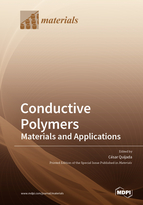Conductive Polymers: Materials and Applications
A special issue of Materials (ISSN 1996-1944). This special issue belongs to the section "Smart Materials".
Deadline for manuscript submissions: closed (31 January 2020) | Viewed by 42728
Special Issue Editor
Interests: electrochemistry of conducting polymers; electrode materials for energy systems and environmental applications; electrochemical processing of textile fabrics
Special Issues, Collections and Topics in MDPI journals
Special Issue Information
Dear Colleagues,
Since the breaktrough discovery of polyacetylene, the first conducting polymer, made by Chemistry Nobel Prize laureates Heeger, MacDiarmid and Shirakawa in the 1970s, the interest in these fascinating family of materials has expanded incessantly to become a well-established area of highly dynamic, multidisciplinary research. The electron conductivity of conducting polymers (CPs) can be easily tuned by facile and reversible doping/dedoping to range from insulating to semiconducting to metallic, thus enabling control of unique optical, physical and redox properties. Jointly with low cost and the vast repertory of synthetic organic chemistry or electrochemistry available to produce lightweight and flexible tailored structures, the above properties have made these materials attractive to a broad spectrum of applications with high technological impact, many of them reaching marketplace. Some usual examples are light-emitting devices and solar cells, electrochromic devices, (bio)sensors and actuators, secondary batteries and supercapacitors, artificial muscles or electromagnetic interference (EMI) shielding and microwave absorbing materials. Additionally, new applications in biomedical science and tissue engineering, in electrochemically-enhanced solid-phase mictroextraction or as adsorbent/ion-exchange materials for environmental issues are emerging as promising growth areas.
This Special Issue is intended to cover the latest advances and developments in the synthesis, characterization, structure-properties relationship and applications of electrically conducting polymers, with particular attention to the role of nanosized shape and the properties of novel CP-inorganic hybrid composite nanostructures. Topics including, but not limiting to, synthesis, characterization and properties study of new conducting polymers from novel functionalized monomer derivatives, development of methods for controlled growth of nanostructures (interfacial, micellar, templated, molecularly imprinted or other structure-directing polymerization), novel hybrid CP composite nanoarchitectures with metal oxide nanoparticles, carbon materials or clays and applications of the above materials in the fields of optoelectronics, energy production and storage, environment, sensing, and so on, are all welcome.
It is my pleasure to invite you to contribute to this Special Issue. Original, high-quality research articles and reviews are encouraged for submission.
Assoc. Prof. Dr. César Quijada
Guest Editor
Manuscript Submission Information
Manuscripts should be submitted online at www.mdpi.com by registering and logging in to this website. Once you are registered, click here to go to the submission form. Manuscripts can be submitted until the deadline. All submissions that pass pre-check are peer-reviewed. Accepted papers will be published continuously in the journal (as soon as accepted) and will be listed together on the special issue website. Research articles, review articles as well as short communications are invited. For planned papers, a title and short abstract (about 100 words) can be sent to the Editorial Office for announcement on this website.
Submitted manuscripts should not have been published previously, nor be under consideration for publication elsewhere (except conference proceedings papers). All manuscripts are thoroughly refereed through a single-blind peer-review process. A guide for authors and other relevant information for submission of manuscripts is available on the Instructions for Authors page. Materials is an international peer-reviewed open access semimonthly journal published by MDPI.
Please visit the Instructions for Authors page before submitting a manuscript. The Article Processing Charge (APC) for publication in this open access journal is 2600 CHF (Swiss Francs). Submitted papers should be well formatted and use good English. Authors may use MDPI's English editing service prior to publication or during author revisions.
Keywords
- Conducting polymers
- Novel functionalized monomers
- Structure-directing polymerization
- Hybrid conducting-polymer-inorganic nano composites
- Structure, properties and materials characterization
- Functional and smart materials
- Optoelectronic and solar cell devices
- Energy generation and storage
- (Bio)sensing and analysis
- Pollution abatement







